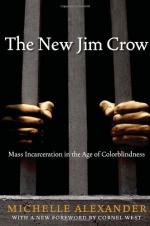
|
| Name: _________________________ | Period: ___________________ |
This test consists of 15 multiple choice questions and 5 short answer questions.
Multiple Choice Questions
1. Who is attributed to the quote in Chapter 5: "The New Jim Crow," "Nothing in all the world is more dangerous than sincere ignorance and conscientious stupidity"?
(a) John Edgar Wideman.
(b) Martin Luther King Jr.
(c) William Berkeley.
(d) W. E. B. Du Bois.
2. The author uses a metaphor in Chapter 5: "The New Jim Crow" to describe the circumstances of white Americans who are harmed by the War on Drugs. To whom are these white Americans compared?
(a) Iraqi civilians harmed by U.S. military operations.
(b) Vietnamese civilians harmed by U.S. military operations.
(c) Afghani civilians harmed by U.S. military operations.
(d) Korean civilians harmed by U.S. military operations.
3. Who wrote The Anatomy of Racial Inequality?
(a) Glenn Loury.
(b) Loic Wacquant.
(c) C. Vann Woodward.
(d) W. E. B. Du Bois.
4. Where did Warren McCleskey commit the crime he was accused of?
(a) Texas.
(b) Mississippi.
(c) Georgia.
(d) Arkansas.
5. When was the Anti-Drug Abuse Act passed that called for strict lease enforcement and eviction of public housing tenants who engage in criminal activity?
(a) 1986.
(b) 1988.
(c) 1975.
(d) 1991.
6. The author asserts in Chapter 5: "The New Jim Crow," "All racial caste systems, not just mass incarceration, have been supported by" what?
(a) "The white community."
(b) "Affirmative action."
(c) "Racial indifference."
(d) "Racial bias."
7. The author asserts in The New Jim Crow that no one has more power in the criminal justice system than whom?
(a) Defendants.
(b) Prosecutors.
(c) Judges.
(d) Defense attorneys.
8. What are the only two states that allow inmates to vote while incarcerated?
(a) Louisiana and Mississippi.
(b) Maine and Vermont.
(c) Texas and Arkansas.
(d) Massachusetts and New York.
9. How many U.S. states prohibit all employers and licensing agencies from considering arrests, according to the author in Chapter 4: "The Cruel Hand"?
(a) Ten.
(b) Five.
(c) Three.
(d) 20.
10. The author asserts in Chapter 3: "The Color of Justice" that in the federal system, homicide offenders account for 0.4% of the past decade's growth in the federal prison population while drug offenders account for what percent of that expansion?
(a) 76%.
(b) 61%.
(c) 29%.
(d) 53%.
11. When was Christopher Lee Armstrong's motel room raided, leading to his arrest for conspiracy to distribute crack cocaine?
(a) May, 1989.
(b) April, 1992.
(c) September, 1991.
(d) June, 2000.
12. The author asserts in Chapter 4: "The Cruel Hand" that anyone convicted of a felony is automatically ineligible for public housing assistance for at least what length of time?
(a) Ten years.
(b) One year.
(c) Two years.
(d) Five years.
13. What percentage of professional black women are unmarried today, according to the author in Chapter 5: "The New Jim Crow"?
(a) 60%.
(b) 70%.
(c) 50%.
(d) 80%.
14. Who is cited in Chapter 4: "The Cruel Hand" as having said, "In this brave new world, punishment for the original offense is no longer enough; one's debt to society is never paid"?
(a) Douglas Blackmon.
(b) Lerone Bennett Jr.
(c) Jeremy Travis.
(d) William Berkeley.
15. When was the Quality Housing and Work Responsibility Act passed, authorizing public housing agencies the ability to exclude and evict drug offenders and other felons from access?
(a) 1998.
(b) 1969.
(c) 2002.
(d) 1994.
Short Answer Questions
1. In June of 2001, how many more black men were in the Illinois state prison system than were enrolled in the state's public universities?
2. Where did Clifford Runoalds return home to attend the funeral of his 18-month-old daughter after he was busted in a drug sweep, according to the author in Chapter 3: "The Color of Justice"?
3. The author notes in Chapter 4: "The Cruel Hand" that two-thirds of people detained in jails report annual incomes under what amount prior to their arrests?
4. For what crime(s) did Warren McCleskey face the death penalty?
5. Where is the See Forever charter school for juvenile offenders?
|
This section contains 599 words (approx. 2 pages at 300 words per page) |

|




